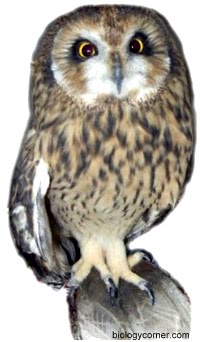Investigation: What Can an Owl Pellet Reveal About Diet?

Owl pellets are masses of bone, teeth, hair, feathers and exoskeletons of various animals preyed upon by raptors, or birds of prey. Pellets are produced and regurgitated not only by owls, but by hawks, eagles and other raptors that swallow their prey whole of in small pieces. Owls feed feed early in the evening and regurgitate a single pellet approximately 20 hours after eating. Unlike snakes, the protein enzymes and strong acids which occur in the digestive tract of raptors do not digest the entire meal. The relatively weak stomach muscles of the bird form the undigested fur, bones, feather etc. into wet slimy pellets. In this process even the most fragile bones are usually preserved unbroken.
The owl pellets that you will be examining in this lab have been collected and fumigated from common barn owls. Owl pellets themselves are ecosystems, providing food and shelter for communities which may include clothes moths, carpet beetles and fungi. Clothes moth larvae are frequently abundant in pellets, feeding on fur and feathers. The black spheres about the size of periods (.) that are found in the pellets are the droppings of the caterpillars. The larvae metamorphose near the surface of a pellet in cocoons made of fur.
Materials
- Owl pellets (http://www.pelletlab.com/)
- Dissecting Needle/toothpicks & tweezers
- Construction Paper, file folders or other paper for mounting bones
- Bone Chart (Owl_Pellet_Bone_Chart_grid.pdf)
Warning: Pellets are sterilized prior to shipment, but they have been known to still harbor salmonella (and other) bacteria. Sterilize area and wash hands after lab.
Procedure
1.Measure the length and width of your owl pellets.
Length of your owl pellet_______ Width of your owl pellet_______ Mass of your owl pellet______
2. Carefully examine the exterior of the pellet. Do you see any signs of fur? _____ any signs of feathers? ____
3.Carefully use a toothpick to break apart the owl pellet and observe what is within. Use a toothpick to expose all bones for identification. Use the bone diagram to help you identify your bones and complete the chart.
Bones Found
| Bone | Type | Number |
|---|---|---|
| Skull | ||
| Jaw | ||
| Scapula | ||
| Forelimb | ||
| Hindlimb | ||
| Pelvic Bone | ||
| Rib | ||
| Vertebrae |
4.Organize the bones into groups and label them, use the attached chart to help you identify bones.Construction paper will serve as a mounting surface. Grade will be based on neatness, labeling and organization.
Analysis Answer each of the following in complete sentences. Your responses should be thorough and show what you have learned in this investigation.
1. What does the owl pellet reveal about the owl's digestive system?
2. Owl pellets not only can give us information about the diet of the owl, owl pellets also provide a habitat for other animals, in fact an owl pellet is a little ecosystem all on its own. Why kind of animals are found in the ìowl pellet ecosystem (Hint: read the background at the beginning)
3. Other types of birds form pellets. What would you expect to find in the pellet of a seagull?
4. Owls, hawks, and eagles are types of raptors, animals which have hooked beaks and sharp claws, and are therefore adapted for seizing prey animals. Hawks and eagles differ from owls in that they eat their prey animals by tearing them into small pieces, picking out the flesh and avoiding most of the fur and bones. They also have strong stomachs which can digest most of the bone material which they might eat. The relatively small amount of indigestible bone and fur that remain will be compacted by their stomach muscles into a pellet similar to the owl's. Do you think an eagle pellet would be as useful for dissecting as an owl's? Why or why not?
5. Construct a diagram of a food web (of at least 5 animals) with an owl at the uppermost trophic level. Use an arrow to show which organism in the consumer or predator.
